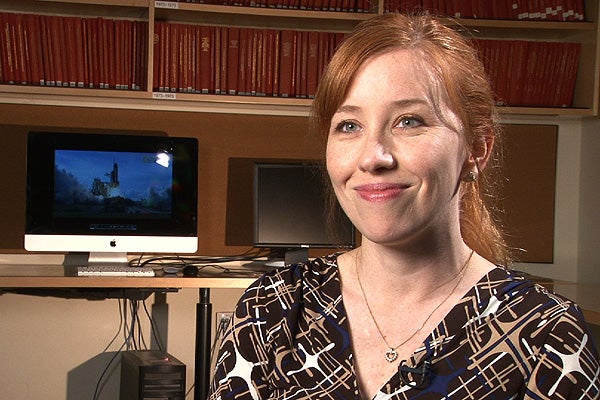|
View video here.
May 19, 2011
Stanford astronautics professor co-hosts Known Universe on National Geographic channel
Known Universe, an eight-part series on the National Geographic channel, has tapped assistant professor of aeronautics and astronautics Sigrid Close as a host. The program looks at space exploration and the science and engineering behind it in a very lively manner, with plenty of demonstrations and experiments to keep things moving. By Louis Bergeron

Stanford assistant professor Sigrid Close says programs such as Known Universe are crucial for attracting the next generation of scientists and engineers. (Photo by Steve Fyffe / Stanford News Service) Sigrid Close believes so strongly in bringing science and engineering to the general public – and making it exciting – that she recently fired a vintage Tommy gun, wielded "a very long" flame torch and spun a turkey carcass in a centrifuge until it began oozing blood and other fluids.
It was all part of her hosting duties for National Geographic's television series Known Universe, which focuses on the exploration of space and the science and engineering behind it. Close, an assistant professor of aeronautics and astronautics, is one of four hosts for the series.
The series, now in its third season on the National Geographic channel, is broadcast on Thursday evenings.
The third episode of the season, "Most Powerful Stars," will be shown tonight. The focus this week is on stars and supernovas – the massive explosions that result when a star collapses in on itself. The explosions can be so bright that some outshine an entire galaxy.
So why was Close firing the Tommy gun at a bull's-eye target in the name of science?
"We were looking at how a gun could represent the way radiation interacts with the human body," she said.
One of her co-hosts, Andy Howell, an astronomer with Las Cumbres Observatory, fired a single shot to represent the amount of radiation a human on Earth absorbs from nature. Close and Howell then rattled off a blast of bullets from the Tommy gun to represent the amount of radiation exposure you could expect if you were on Mars.
The difference arises because Earth's atmosphere and magnetic field act to filter the radiation we receive from space, but Mars has no magnetic field to keep radiation from blasting its surface at full force.
"Using guns and bullets to make the analogy of what it is like to live in space may be a little bit loose, but I think the producers actually were able to pull it off in a realistic and fun way," Close said.
And what did they conclude from the demonstration? "It's safer living on Earth, of course, at least when it comes to surviving cosmic radiation," Close said.
The big challenge with the series, she said, is keeping the science and engineering accurate while making the experiments and demonstrations fun for viewers.
"But I think Known Universe has done a really good job of making sure that they have the technical part correct," Close said.
Close usually spends her time doing research on hypervelocity impacts on spacecraft – specifically, how tiny meteoroids can knock a satellite out of commission even though they're far too tiny to actually break anything.
Failure of satellites is an ongoing problem in space and with some of the failures, no one has really figured out the cause. Close is working on the theory that if the tiny impacts happen at high enough speeds, they can generate an electrically charged gas called plasma. The electric field of the plasma may be sufficient to disrupt the functioning of the satellite or even disable it.
Close was willing to put in the extra hours for the program on top of her teaching and research because she's convinced that programs such as Known Universe, which take an engaging approach to doing science outreach, are crucial.
"It is that reaching out and inspiring people that will drive the next generation of scientists and engineers," she said. "My two young daughters are both really interested in the program because it is exciting and fun, not because they know how to do the equations."
So what was the flame torch used for?
"That was a test to determine whether Mars' magnetic field could have died during a period of heavy bombardment by asteroids," she said. The bombardment would have subsequently heated up the planet, which could have killed the magnetic field. So for the experiment, Close heated up a magnet – hence the torch.
"That experiment, I was a little worried that I was going to burn my hair off," she said. "But they had protective gear and big gloves, so I was safe."
As for centrifuging the turkey, Close said that was done to convey how the human body would react to an environment with a strong gravitational field.
The turkey was spun to simulate a high level of gravity and eventually the pressure became so intense that the carcass began to ooze fluids.
"It was somewhere between 50 and 100 Gs where the carcass went smush," she said. "As a vegetarian, that was a little bit disgusting, to be honest."
Asked to sum up the overall experience of hosting the show, Close replied, "They definitely stretched the boundaries of what I have done in my life with some of the experiments, but how often am I going to get the opportunity to co-host a show on the National Geographic channel?"
Or, for that matter, to fire a Tommy gun like a Depression-era G-man, try to incinerate a magnet or centrifuge a turkey?
The other hosts of the series are astronomer Andy Howell, who is an adjunct faculty member at the University of California-Santa Barbara; David Kaplan, a professor in the Department of Physics and Astronomy at Johns Hopkins University; and Mike Massimino, an astronaut in the U.S. space program and veteran of two shuttle missions.
-30-
|